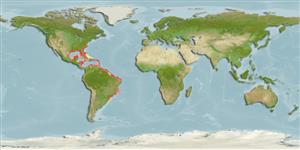Ophiuroidea |
Amphilepidida |
Amphiuridae
Environment: milieu / climate zone / djupintervall / distribution range
Ekologi
; djupintervall 0 - 160 m (Ref. 111335). Tropical
Southwest Atlantic: Brazil.
Length at first maturity / Size / Weight / Age
Könsmognad: Lm ? range ? - ? cm
Found on mangrove swamp (Ref. 111335).
Life cycle and mating behavior
Könsmognad | Reproduktion | Lek | Eggs | Fecundity | Larvae
Members of the class Ophiuroidea are mostly gonochoric, others are protandric. Fertilization is external. Brooding is common, bursae is used as brood chambers where the embryos develop into juveniles and later crawl out from the bursal slits. Life cycle: Embryos hatch into free-swimming planktotrophic larvae and later metamorphose into tiny brittle stars which sink down the bottom where they grow into adult form.
Borges, M. and A.C.Z. Amaral 2007 Ophiuroidea (Echinodermata): quatro novas ocorrências para o Brasil. Rev. Bras. Zool. 24(4):855-864. (Ref. 83288)
IUCN Red List Status
(Ref. 130435: Version 2025-1)
CITES status (Ref. 108899)
Not Evaluated
Not Evaluated
Threat to humans
Human uses
| FishSource |
Verktyg
Ytterligare information
Trophic EcologyFood items (preys)
Födosammansättning
Födointag
Predatorer
Population dynamicsTillväxtMax. ages / sizesLength-weight rel.Length-length rel.Length-frequenciesMass conversionAbundans PhysiologySyreförbrukning
Human RelatedStamps, coins, misc.
Internet-källor
Estimates based on models
Price category
Unknown.
